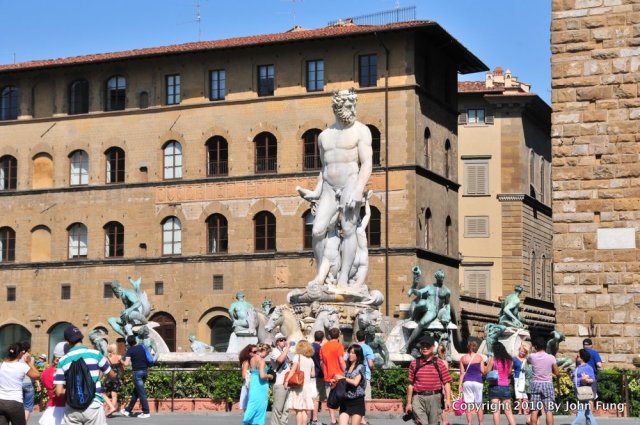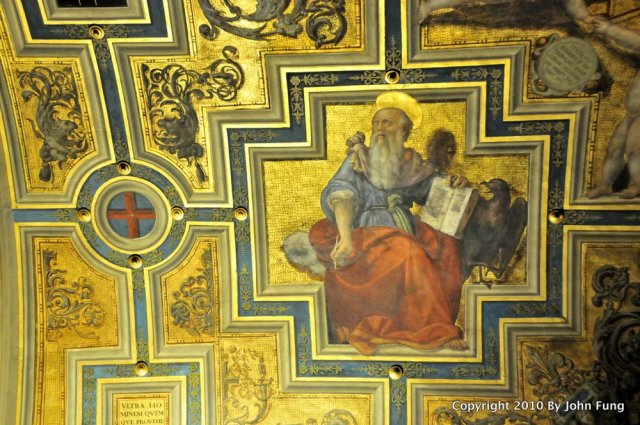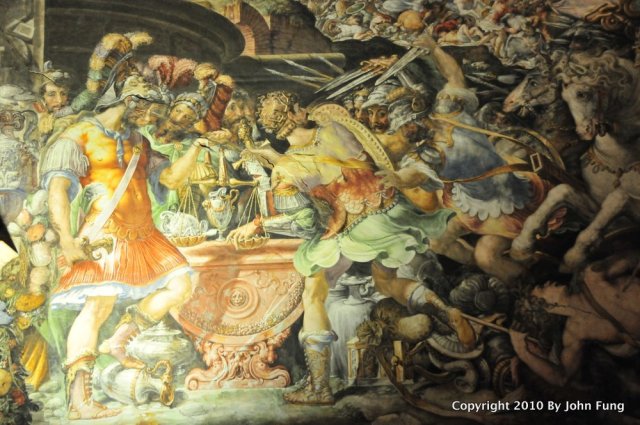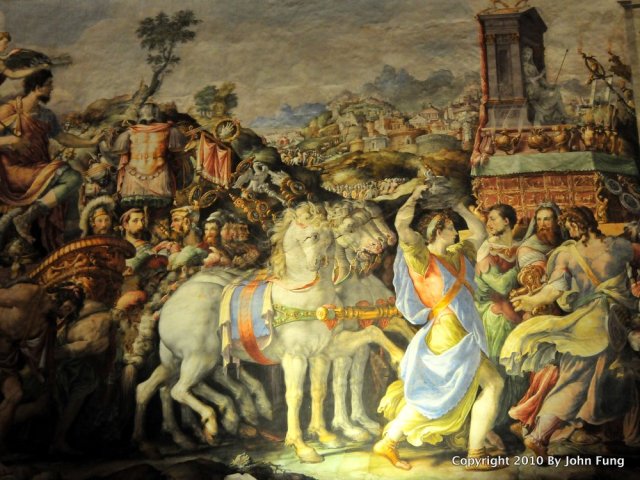市政廳廣場是翡冷翠市政廳前的廣場。多個世紀來這裡是翡冷翠城邦的政經文化中心, 廣場上市政廳的鐘樓曾發出召集公眾開會論政的鐘聲。十九世紀, 翡冷翠是意大利首都時, 市政廳內的”五百廳”(Salone dei Cinquecento) 就是五百名國會議員開會的地方。市政廳是遊客必到的地標, 整日遊人如鯽。廣場上除市政廳外, 旁邊就是傭兵凉廊和烏菲茲博物館。 我們經過這裡好幾次(所以有不同時段拍的照片), 都沒有時間入內, 遑論找個時間坐下來享受它的氣氛。後來得知道市政廳開放至午夜, 我們遂於離翡冷翠前一夜入內参觀。
Piazza della Signoria, or Piazza Vecchio, is the square in front of the Palazzo della Signoria. This square has been the focal point of the political and social life of Florence for centuries. Today, Piazza della Signoria is not just a civic center but also an open air museum and a popular promenade for tourists. Across the entrance of Palazzo Vecchio is the Loggia dei Lanzi which showcases an impressive collection of sculptures. Galleria degli Uffizi is the U shape building behind Loggia dei Lanzi. The square is truly a place of incomparable beauty and elegance.

市政廳之晨。騎馬塑像為麥迪奇公爵。 Cosimo I de’ Medici, Grand Duke of Tuscany, equestrian statue by Giambologna. Palazzo Vecchio in the early morning sum.
————————————————————————————————————-
傭兵凉廊或稱市政廳涼廊是翡冷翠市政廳廣場上一建築物, 建於1376-1382. 麥迪奇公爵的僱傭兵曾駐在此, 故名之。涼廊位於市政廳大門前, 其背後即為烏菲茲博物館。凉廊的建築線條甚美, 據說米開朗基羅曾建議涼廊的拱型建築延伸至整個廣場的周圍。
The Loggia dei Lanzi is a building in front of the Palazzo della Signoria, adjoining the Uffizi Gallery. It is said that Michelangelo actually proposed that the arches (loggia) should be extended to the whole parameter of the piazza. The Loggia served to hold public ceremonies and to house assemblies and eventually turned into the a gallery for sculptures. It derived its name Loggia dei Lanzi dates back to the reign of Grand Duke Cosimo I, when it was used to house his landsknechts (Lanzi in Italian) or German mercenary pikemen.

Perseus 是宙斯的兒子, 神話中以殺蛇髮女妖著名。 Perseus by Benvenuto Cellini (1554). The original is displayed in the Museo Nazionale del Bargello.

Perseus 手持女妖梅杜莎的頭。據說此雕像的制作及公開展示是重掌政權的麥迪奇公爵要向敵人示警。 Perseus beheading Medusa was intended to warn the enemies of the Duke of Tuscany, Cosimo I, of their probable fate.

此手造形之美, 不像一剛被砍頭的女妖所有。 Detail of the hand of Medusa. It doesn’t appear to me that this belongs to a person who has just been beheaded.

Hercules 是希臘神話中的大力士英雄, 在制服一人頭馬。Hercules and the Centaur by Giambologna with the help of Pietro Francavilla.

這是希臘詩人荷馬敍事史詩的一幕, 是根據希臘原作重雕的作品。 Menelaus Holding the Body of Patroclus, Roman copy (Flavian era) of a Greek original (240-230 BC).
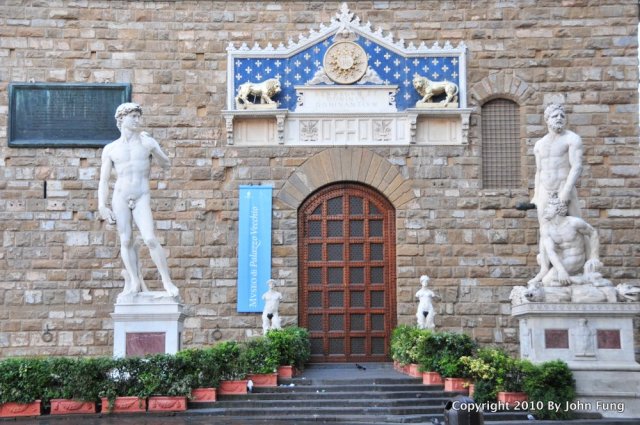
市政廳的大門, 左為大偉的雕像; 右為Hercules 壓制Cacus, 據說是麥迪奇展示重掌政權的實力(Hercules為傳說的大力士)。 The main door of Palazzo Vecchio, David on the left (the original is in the Galleria dell’ Accademia). On the right, Bandinelli’s Hercules and Cacus (which was appropriated by the Medici to show their power after their return from exile).

米開朗基羅的大衛, 有說大偉雕像是為了藐視專制的麥迪奇而制 (大偉是聖經裡擊敗巨人的少年)。David by Michelangelo (copy). Some say David was placed in front of Palazzo Vecchio as a symbol of the Republic’s defiance of the tyrannical Medici.

瓦薩里庭園, 中為Verrocchio 的小天使噴水池。 Vasari’s courtyard. A copy of Verrocchio’s Putto situated in the middle of the courtyard.

凉廊內的壁画。Vasari’s courtyard. The frescoes on the walls, representing scenes of the Austrian Habsbury estates, were painted in 1565 by Giorgio Vasari for the wedding celebration of Francesco I de’ Medici.
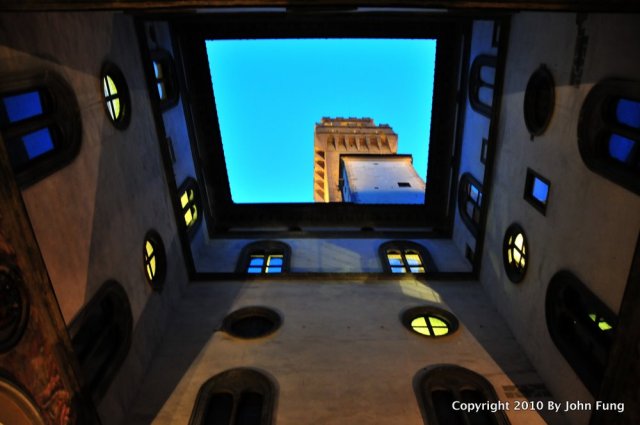
晚上八時所見的中庭。We finally managed to squeeze some time, at the night before leaving for Rome, to tour the palazzo.
————————————————————————————————————
市政廳內部:
正如前面提過, 我們是在翡冷翠最後一个晚上(第七天的晚上)去参觀的。其實我們有好幾個重量級的景點都因時間不對而要留待下回, 為何戰至最後一刻仍要去市政廳呢? 主要是去看看”五百廳”,了個心願。好多年前曾看過一紀錄片, 如果沒記錯, 是有關五百廳的壁画的。現在五百廳的壁画多為瓦薩里的戰爭圖, 據說達文西和米開朗基羅都曾受聘為五百廳作画。據說達文西的因試用新的顏料失敗而放棄,後來被覆蓋了; 而米開朗基羅的還在素描階段就被請去画西斯汀教堂了。可是紀錄片中說, 他們用雷射發現現存的牆後有另一幅牆, 相距僅一、二呎而已, 米開朗基羅的壁画好可能就在裡面云云。多年來就為了這模糊的印象想來看看五百廳 (其實可能記錯了, 不是五百廳)。那個晚上實在已是強弩之末, 上樓梯確是舉步維艱, 怱怱的走了一遍, 真的是且戰且走。
The Interior of Palazzo Vecchio
On our last day in Florence, we finally managed to take advantage of their long opening hours to visit Palazzo Vecchio. We thought about saving Palazzo Vecchio for our next visit. However, we wanted to see Salone dei Cinquecento (Hall of the Five Hundred) so badly so we dragged ourselves to the Palazzo after dinner break. We were physically exhausted and didn’t have much energy to follow the map. Today, the only thing I have a solid recollection is the Salone dei Cinquecento. The hall is imposing, even by today’s standard. The walls are covered by Vasari’s battle scenes. If my memory serves me well, I once watched a documentary reporting that Michelangel was commissioned to paint the Battle of Cascina in the chamber and Leonardo da Vinci for the Battle of Anghiari . However, Leonardo started the work in 1505 with a new color technique and abandoned the project when the technique turned sour. Michelangelo worked from 1504-5 on the cartoon before being summoned to Rome to work on Sistine Chapel. However, the documentary reported that recent laser technique had revealed a hidden wall behind Vasari’s mural. It appeared that a new wall was built in front of Michelangelo’s mural (?) for Vasari to paint his mural. I am not sure to what extend my memory was correct. Anyway, this was the reason I had to see the chamber.

巨大的五百廳, 義大利的建築技術真的是令人五體投地。The imposing Salone dei Cinquecento (Hall of the Five Hundred) derives its name from the five hundred members of Parliament who met here when Florence was the capital of Italy (1865-71).
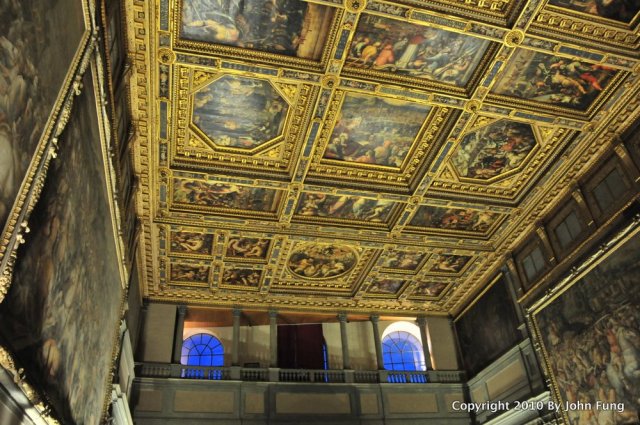
五百廳另一方, 難怪可容五百人開會。 Salone dei Cinquecento. (1495), looking west. The lighting at night was kind of weird, I would have preferred to visit at day time.

五百廳的天花, 描繪翡冷翠的歴史。The ceiling of Salone dei Cinquecento consists of 39 panels, each presents an epoch in the history of Florence.
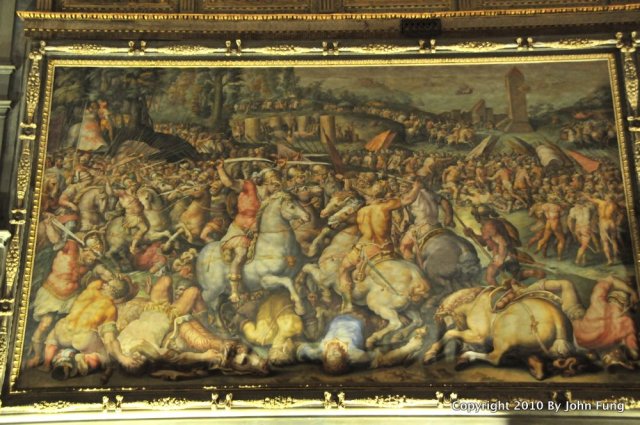
瓦薩里 – 雲仙素塔前大敗比薩軍。 Defeat of the Pisans at the Tower of San Vincenzo (La sconfitta dei pisani alla torre di San Vincenzo) by Giorgio Vasari.

瓦薩里 – 翡冷翠軍攻擊比薩。 Pisa Attacked by the Florentine Troops (Pisa attaccata dalle truppe fiorentine) by Giorgio vasari.

Bronzino 画的壁画, 摩西擊磐石出水。Moses striking water from the rock. Fresco by Il Bronzino (Agnolo di Cosimo). Look familiar? He was a Mannerist, a student of Pontormo.

This fresco is situated between the two paintings of the Story of Furious Camillus. Very likely by Salviati as well.
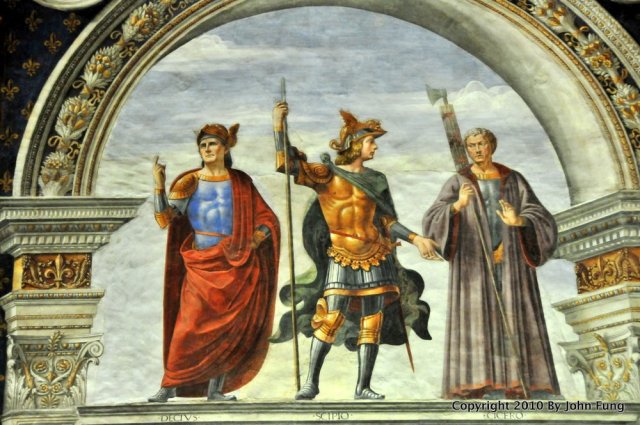
米開朗基羅老師Ghirlandaio在市政廳的壁画, 描畫歴史人物。 Decoration of the Sala del Gigli by Domenico Ghirlandaio. Decius, Scipio and Cicero are depicted.
————————————————————————————————————————
烏菲茲博物館 Galleria degli Uffizi
無論你是否喜歡藝術, 烏菲茲博物館是不容錯過的。 建議行前在網上訂門票, 可免排隊久候之苦, 旅遊旺季時據說要排一、两個小時。這裡收藏着無數的名作, 很多都是世界級的極品。對我來說, 波提切利的幾幅作品真的令人心醉。我們去的時候, 還有特別展, 是Caravaggio 式的繪畫。畫作不單是好, 而且數量很多, 可惜不能拍照, 不能回來細看。博物館外有著名藝術家的雕像, 拍幾張留念。
Without a doubt, Uffizi is a must-see for everybody. For tickets, a reservation is highly recommended. The line for tickets was very long probably due to the fact that summer is the peak season. Photography is prohibited in the gallery, and we followed the rule. The official guide book is nicely compiled, almost all the major works are pictured there, and that’s reason why I was not that enthusiastic to break the rules. However, before allowing my camera to take a break, I managed to take a few pictures of some of the famous artists on the niches outside Uffizi.









